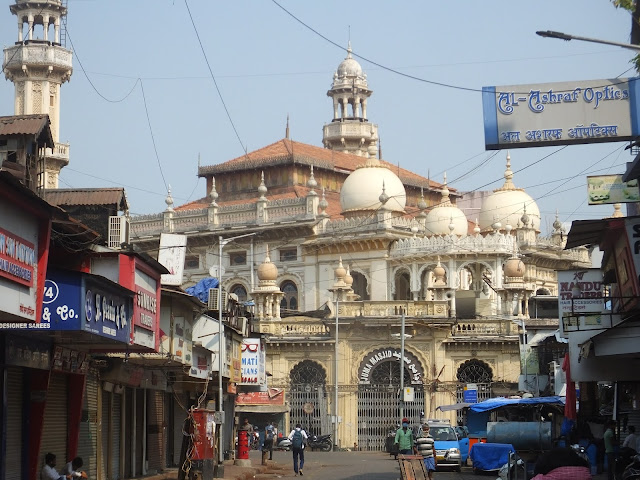Juma Masjid walk - The oldest masjid built by Konkani Muslim family in Mumbai
Juma Masjid, also known as Jumma Masjid (Friday Mosque) is one of the oldest mosques in the city of Mumbai. Its present location is in the busy market junction in the Kalbadevi area near Crawford market. But this was not always the location. Initially, it was constructed at Dongri near Crawford market but then it was shifted on the Esplanade road outside the fort walls. Due to its proximity to the fort walls, objections were raised by then-governor William Hornby, so it was again shifted back near Crawford market at Kalbadevi and constructed over 27 years period starting from 1775.
The Masjid is built on a large reservoir and open land which was owned by a Konkani Muslim family of Mohammed Ali Roghay who was a philanthropist and prominent citizen of Bombay. He laid down conditions that the water tank will need to be preserved while constructing the Masjid. Hence even today there exists a water tank on which 16 arches have been built which acts as a foundation for the two and a half storied masjid. Though initially only one-storied was built which was later expanded in 1814.
The Masjid is built in quadrangular shape with bricks and stone and encircled by a terraced roof. The main eastern entrance gate leads to the courtyard and to the original water tank which has about 10 feet of water and is used for ablution purposes. Semi circular masonry steps and embankment are constructed around the tank. The green algae make the water look greener which has a lot of fishes and turtles in it.
A very beautifully carved wooden staircase leads one to the main prayer hall which is one huge hall with cast-iron pillars. The prayer hall is an eye-popping beauty if you are seeing it for the first time. Stucco works on the ceilings and walls, lavish use of marbles with intricate designs and huge chandeliers hanging from the ceilings is the highlight of the prayer hall.
The prayer hall is actually a hanging structure supported by cast-iron pillars, The brackets of the pillars are gold plated. Each pillar has a wood stand holding religious books and the prayer beads also called misbaha. The hall is huge and quite airy with abundant sunlight coming from multiple doors and windows. Quranic verses are painted above the windows colorful panels.
On the western side of the hall, there is a known as "Qibla" is the scared side facing the "Kabba". Every Muslim in the world faces this direction during the prayers and it has a beautiful pulpit called "mimber" on which the priest or Imam stands to give sermons. The pulpit at Jama Masjid is a majestic and intricately carved marble structure with steps used by the priest.
Mihrab or the niche in the wall is another essential element in mosque architecture that indicates the direction of Mecca towards which all Muslims pray. In Juma Masjid the mihrab is an arched space, a very beautifully carved marble structure in the wall with some verses written in gold.
The beauty of the prayer hall is literally eye-popping and words don't do justice to it, It has to be seen to soak in its beauty and grandeur.
Another prayer hall is situated on the second floor which is equally beautiful. A huge chandelier illuminates the hall, hanging in the middle from the ceiling which is covered with beautiful stucco works. The hall has a hanging ceiling with no supporting pillars. This prayer hall also has multiple windows which bring in abundant natural light. The marble work on the wall is truly a delight to see and speaks volumes of the artisans who have worked on it.
Both the halls have a capacity of 2000 people and are covered with carpets. Outside the hall, there is a beautiful corridor with marble arches with floral design and marble flooring. The corridor overlooks the water tank below. The terrace is adorned with small minarets and gumbaz or dome-shaped structures known as "Qubba". Qubba is a symbolic representation of the special vault of heaven in Islamic architecture.
Jama Masjid maintains a well-stocked library for religious scholars and students, They have a huge collection of religious books and old manuscripts dating back 200 years which also have been digitized.
A locked staircase from the terrace takes us to a sloping roof covered in Mangalore tiles, This portion is usually out of bounds for the general public. A series of small steps on the roof takes us to a structure that holds the architectural secret. The structure holds the entire mechanism on which the hanging roof and two-storied mosque rest.
On the northeast and northwest ends stands two minarets which not only serves the place from where the start of prayers is announced but it is also from here that the moon sighting is done by "chand committee" members. Juma Masjid is the authority in Mumbai which announces the sighting after which the Holy month of Ramzan starts and ends. The sighting is also done every month.
Juma Masjid of Mumbai is a majestic structure surrounded by busy market areas but once inside, it is an oasis of peace, serenity, and tranquility. The architectural marvel, as well as the grandeur beauty inside the mosque, cannot be described in words but needs to be experienced by a visit.
Juma Masjid of Mumbai is managed by a trust whose members are always from the Konkani Muslim community. The masjid also runs Madrassa school providing religious education and hostel facilities.
They recently opened the masjid for non-Muslims and conducted a wonderful walk providing access and opportunity to visit the place. The heritage walk inside the mosque may become a regular affair in the future and would be an excellent opportunity especially for heritage enthusiasts across the city to have one more place ticked off their bucket list.
































Comments
Post a Comment